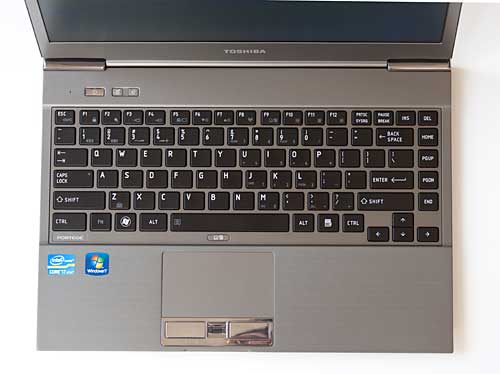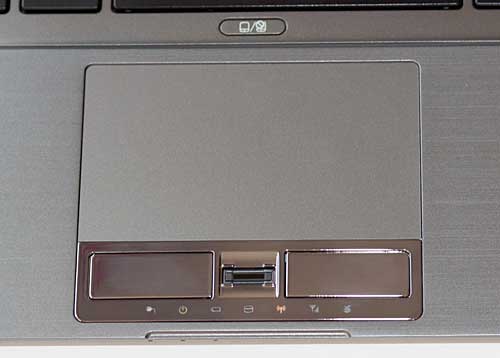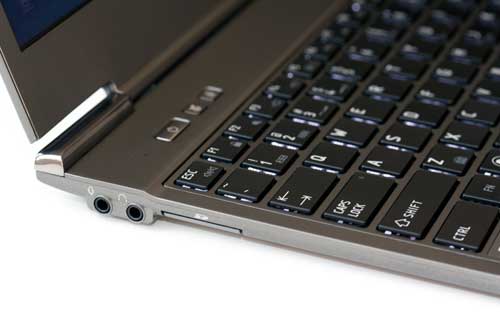Display and Keyboard
The machine has the usual 1366 x 768 TN LED backlit panel, making Asus the leader in Ultrabook resolution with their 1600 x 900 resolution Zenbook UX31. The Z830 has a matte display while the Z835 line has a glossy display. You can build to order with either display and there's no price difference. In terms of display quality, they're quite similar and neither has stunning brightness, though they're perfectly adequate for indoor use. Colors on the matte display are very rich (a tad oversaturated looking when brightness is set high), and contrast is good for a matte display. We noted higher apparent contrast vs. the Samsung Series 7 Chronos 15.6" laptop that also ships with a matte TN display.
Viewing angles aren't great, which is typical of the TN panels used on most non-premium notebooks. This ain't no IPS display, and we've yet to see a really high quality display on an Ultrabook given the $1,000 price target set by Intel. The Zenbook has the best display among Ultrabooks, but it too has limited viewing angles. Color saturation and contrast increase as you tilt the panel back, and the panel pales when tipped toward you. Side viewing angles are better.
The keyboard is backlit in white, and by default uses a timer to save power (most annoying). We turned off the aggressively short timer function and enjoyed the non-jarring white backlight. The letters and numbers illuminate, and you can see LED light peeking out from the four corners of each key.
The keyboard is spacious by 13" standards, and there's good spacing between the discrete keys. Key travel is low and there's not a lot of tactile feedback, which is a common problem with extremely thin laptops. We had problems with missed keystrokes, particularly the spacebar. So far, the only Ultrabook keyboards we've really enjoyed are the HP Folio 13 and MacBook Air. The keyboard isn't a horror, but if you spend your days writing thousands of words as I do, it will get on your nerves.
The Synaptics trackpad is slightly offset to the left, and it has chromed buttons that are a little slippery and stiff--a deadly combination. My finger tended to slip off the key as I tried to apply sufficient pressure. Again, it's not a dealbreaker, but it could've been done better. The trackpad supports multi-touch and gestures, and though small, there's enough room to make use of these features. The fingerprint scanner lives between the two mouse buttons.
Performance and Horsepower
Our review unit is the maxed out $1,429 model with a 1.8GHz Intel Core i7-2677M ULV CPU, 6 gigs of DDR3 RAM (most Ultrabooks have 4 gigs) and a fast Toshiba 128 gig SSD (currently the only drive option). Toshiba says that RAM isn't user upgradeable, so if you want 6 gigs, you'll need to order the machine with 6 gigs rather than upgrade it later yourself.
Performance is very good and it's nearly as fast on benchmarks as the class-leading Zenbook UX31. It scores 9938 on PCMark Vantage, and that number is bolstered by an insanely fast 19,000 score for the HDD benchmark. Because PCMark Vantage weighs disk performance heavily, the total score is optimistically high. This is a ULV (low power) CPU with integrated graphics, yet it scores higher than a performance notebook with full mobile Core i7, dedicated graphics and a conventional 7200 RPM hard drive. So, despite the numbers, the Z830 isn't as fast as the 2012 HP Envy 15 in real world use. And no, it won't play Crysis 2 or other demanding current 3D titles in a usable way since it has only integrated graphics. The GPU is good enough for fluid Photoshop performance, and casual games are fine.
Ultrabooks aren't hot nor are they noisy. Despite thin designs and sometimes conductive metal bottom panels, they keep their cool thanks to the ultra low power CPU and integrated graphics. The Toshiba Z830's fan spins all the time (there are power options to select faster and louder or quieter and slower), but it's fairly quiet though high-pitched. When watching Adobe Flash video for 30 minutes (plugged into power) the fan did not kick up appreciably in speed or volume. It's quiet compared to most full sized notebooks and it doesn't get terribly hot. In fact, the CPU runs at 800MHz most of the time when playing Flash video and CPU temps average a relatively cool 46 degrees Centigrade. The CPU is located toward the back center of the machine so the wrist rest area stays cool. The Toshiba Portege Z830 is quieter than the Lenovo IdeaPad U300s and Asus Zenbook UX31.
Benchmarks
PCMark Vantage: 9938
Memories: 5896
TV and Movies: 4034
Gaming: 7853
Music: 12,865
Communications: 10,493
Productivity: 11,132
HDD: 19,307
Windows Experience Index:
Processor: 6.9
Memory: 7.3
Graphics (Aero): 5.9
Graphics (Gaming): 6.2
HDD: 6.7
Conclusion
The Toshiba Portege Z830 is the best equipped and lightest Ultrabook currently on the market. It has more ports and you won't feel like you've given up expandability for extreme portability. It's insanely light at 2.48 lbs. and very thin. In short, it's a real pleasure to carry. That diet has a drawback or two though: there's lots of lid flex and the notebook has a hollow feel to it when you press surfaces.
Ultrabooks are an Intel initiative with a series of standard recommended specs, and that means you won't see lots of variation among the brands. In terms of horsepower, the Toshiba fits in with the crowd and we're glad they didn't skimp and drop a few features like the SSD drive to make the Z835 line cheaper. The Intel Core i5 and i7 models are fast enough for everyday work, casual gaming, video streaming and image editing, but like all Ultrabooks, they're not serious 3D gaming machines nor would I choose one for HD video editing. Should you get the Portege Z830 or Z835? If you want a matte display and a fingerprint scanner, the Z830 is your best choice. If those don't matter to you, save several hundred dollars and go with a Z835.
Price: $1,429 as tested, price starts at $899 for the Z835 with Intel Core i3 CPU.
Website: www.toshiba.com
Related Reading:
Ultrabook Guide
Best Ultrabooks Rated |



The Portege Z830 has separate mic and headphone jacks. |

